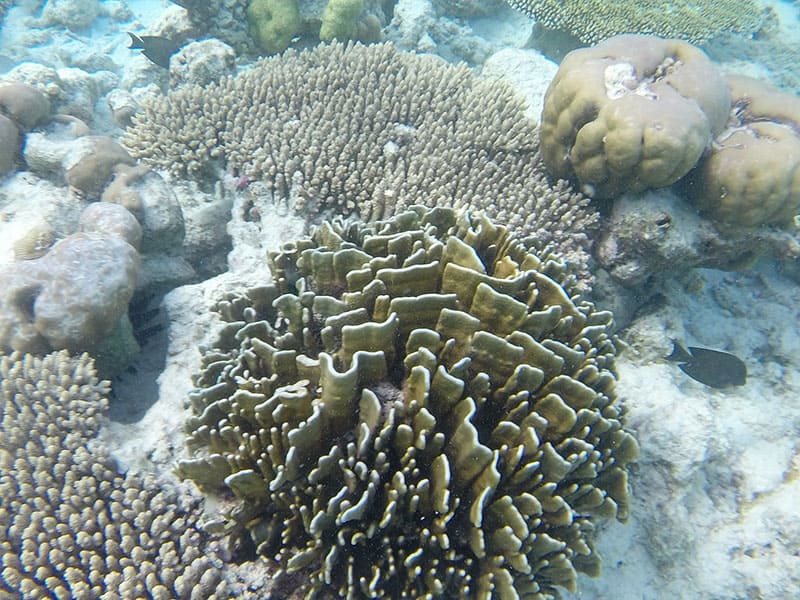The handsome Leather corals make some of the best beginner soft corals for the reef aquarium!
Leather corals are a soft coral with a rather tough leathery skin. They come in all sorts of attractive shapes and can be quite dynamic in the reef aquarium. They can change form by expanding and deflating their body or extending and retracting their tentacles.
They are considered to be some of the best soft corals for beginners. Many of the readily available species are easy to keep with great success. Yet advanced reef keepers also favor these soft corals, as they offer a nice visual balance to the tank. Many types of Leather Corals are easy to care for, especially corals in the Sarcophyton, Lobophytum, Sinularia, and Cladiella genera.
A number of the well-known “true” Soft Corals can also make great beginner corals. Besides the Leather and Soft Corals, there are hundreds of other different types of soft corals. These include Gorgonians and other unique Octocorals like the Blue Coral, Organ Pipe Coral, Green Star Polyps, and the Sea Pens. Each of these beautiful corals will have care requirements that are just as diverse as the animals they are; consequently not all soft corals are easy keepers. It is very important to learn about the species you are keeping for a successful reef aquarium.
For information about other types of soft corals, see:
What Are Octocorals?
Introducing Soft Corals and the Subclass Octocorallia
Leather Coral Facts
Like other types of soft corals, Leather Corals are primarily colonial sessile animals, meaning they are anchored firmly to the substrate. They have a surface, a soft membranous matrix, that is covered with polyps. These corals, as well as all the soft corals, are also part of the Subclass Octocorallia known as the Octocorals. These are defined as corals, that for each polyp, has the characteristic eight pinnate tentacles and eight septa used to gather and distribute food to the colony.
The polyps of different Leather Coral varieties can have long or short tentacles, stalks of different lengths, or no stalks at all. When their polyps are extended they can appear fuzzy, yet have a smooth surface when they are retracted. They come in many colors, with hues of yellow, orange, red, olive, rust, and purple being most predominant.
Soft Corals for Beginners
Leather Corals are favored by reef aquarists and also by advance keepers. There are a number of readily available species. Some Leather Corals that can be easily kept include:
- Colt Coral – Cladiella Sp.
- Common Toadstool Coral – Sarcophyton glaucum
- Yellow Leather Coral – Sarcophyton elegans
- Yellow Toadstool Leather Coral – Sarcophyton tenuispiculatum
- Elephant Ear Coral – Sarcophyton trocheliophorum
- Cabbage Leather Coral – Lobophytum crassum
- Devil’s Hand Coral – Lobophytum Sp.
- Cabbage Leather Coral – Sinularia dura
- Finger Leather Coral – Sinularia notanda
Some Leather Corals that are moderate to care for include:
- Yellow Leather Coral – Sarcophyton elegans
- Flexible Leather Coral – Sinularia flexibilis
- Long Polyp Leather Coral Sarcophyton ehrenbergi
Leather Coral Care
Leather Corals are generally very hardy and will thrive in a properly maintained reef aquarium. Most need a moderate to strong water flow and tend to do very well under various types of reef tank fluorescent lighting. Metal halides are not needed. They are also easy to propagate in captivity by simply cutting them into coral frags
They frequently contain the marine algae, zooxanthellae, and therefore do well in bright light. Leather Corals also require currents to help them slough off a milky slime on their surface. They produced this to rid themselves of any algae or other irritants that may be present on the skin. Sometimes they will shrink, and may appear to be dying. This is a natural event where they shed their outer layer and then regrow it. When you see this, they are generally fine and it will just take a little time before they are back to normal.
Leather Corals will sometimes become a surrogate host for clownfish, if there is no host anemone available. However Leathers can be toxic to other sessile tank mates. They don’t have a strong sting from their tentacles, but they do emit chemicals to ward off other corals competing for the same space. Provide plenty of room between them and other corals, at least a few inches.
Feeding Leather Corals
Leather Corals that contain zooxanthellae also derive the majority of their nutrition from it. But many will eagerly accept small foods like brine shrimp and plankton. Some may be fed microplankton, this is especially important if the light is not on the higher end.
Leather Coral Facts – Types of Leather Corals, Soft Corals for Beginners
Featured Image Credit: Heliopora coerulea Maldives by Frédéric Ducarme, Wikimedia Commons CC SA 4.0 International










